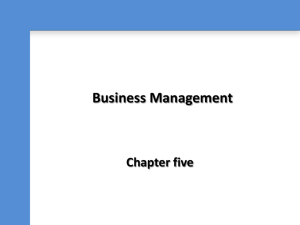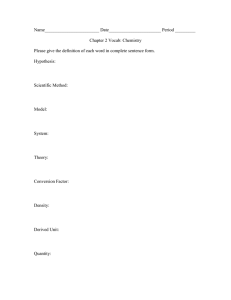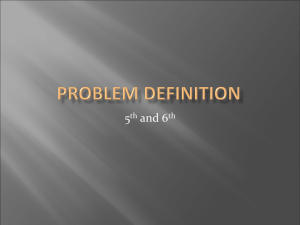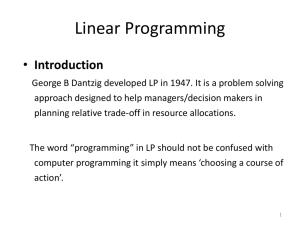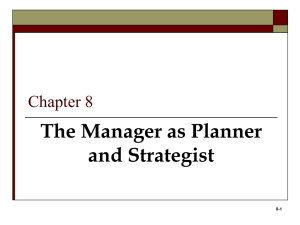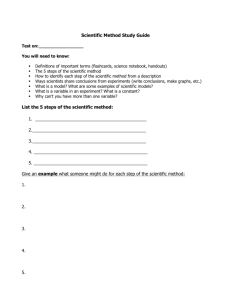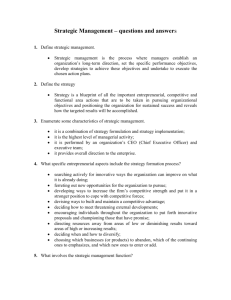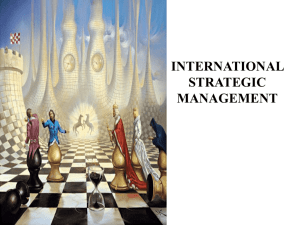Chapter IV Strategic Planning and Organizational Objectives
advertisement
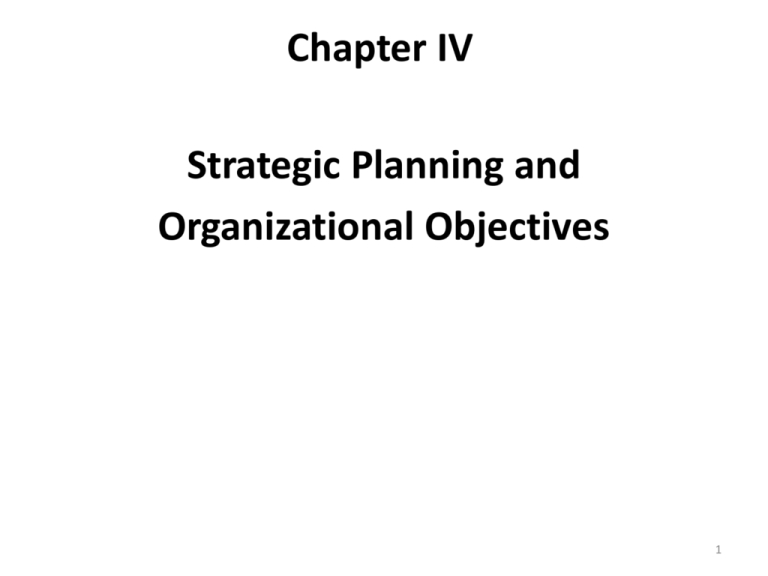
Chapter IV Strategic Planning and Organizational Objectives 1 Learning Objectives When you finish this chapter, you should be able to: Nature of strategic planning Levels of strategy Importance of strategy plan Steps in the strategic planning process Defining the mission of the organization Developing the organizational objectives Assessing organizational resources, risks, and opportunities Formulating strategy Implementing strategy 2 I. Nature of strategic planning Strategic planning is an organization's process of defining its strategy, or direction, and making decisions on allocating its resources to pursue this strategy, including its capital and people. 1.1 Levels of strategy Strategy can be formulated on three different levels: -corporate level -business unit level -functional or departmental level. 1.2 The importance of strategy plan: -We all need to know where we are going -Plan is the compass 3 4 II. Steps in the strategic planning process Steps in the strategic planning process: Mission Assessing: Resource, Risks, and Opportunities Formulating Strategy Feedback Objective Implementing Strategy Monitoring & Adapting Strategic Plans 5 2.1 Defining the mission of organization The mission statement should be a clear and succinct representation of the enterprise's purpose for existence. What do we do business? Who is our customers? What should we provide goods/services? 6 2.2 Developing the organizational objectives: Objectives give the business a clearly defined target. Create the road or approach 7 2.3 Assessing organizational resources, risks, and opportunities Manager must analyze SWOT And compare to other organizations 8 SWOT Analysis Strengths -Profits -Financial Resources -Honest Customers -Modern Physic Equipments -Patent Opportunities Ability Weaknesses -Small line-products -Lack of management -Poor finance -Poor market -High cost of labor -Increasing of demands -Entrance new markets -Buy technologic company -Increasing of products Treats Problems -Changes of customers’ demands -Government’s policies 9 2.4 Formulating Strategy: Environmental Strategies: (Focusing on resources related to environment) Strategic Model: Mr. Miles and Mr. Snow discovered 4 strategies: a. Prospector: new opportunity, & high risk >new products>new markets b. Defender: marketing stability, no changing c. Analyzer: aggregating prospector & defender d. Reactor: always no show clear plan, have trends to exchange of opportunity. 10 2.4 Formulating Strategy: Strategic Window: Duration of limited time Main tasks of markets appropriated to ability of company Monitoring external environment 11 2.4 Formulating Strategy: Strategic Business Unit (SBU): is understood as a business unit within the overall corporate identity which is distinguishable from other business because it serves a defined external market where management can conduct strategic planning in relation to products and markets. 12 2.5 Implementing Strategy: The selected strategy is implemented by means of programs, budgets, and procedures. Implementation involves organization of the firm's resources and motivation of the staff to achieve objectives. 13 14 National HIV/AIDS Strategy Implementation 15 2.6 Monitoring and Adapting Strategic Plans: Evaluation and control consists of the following steps: Define parameters to be measured Define target values for those parameters Perform measurements Compare measured results to the pre-defined standard Make necessary changes 16 17
